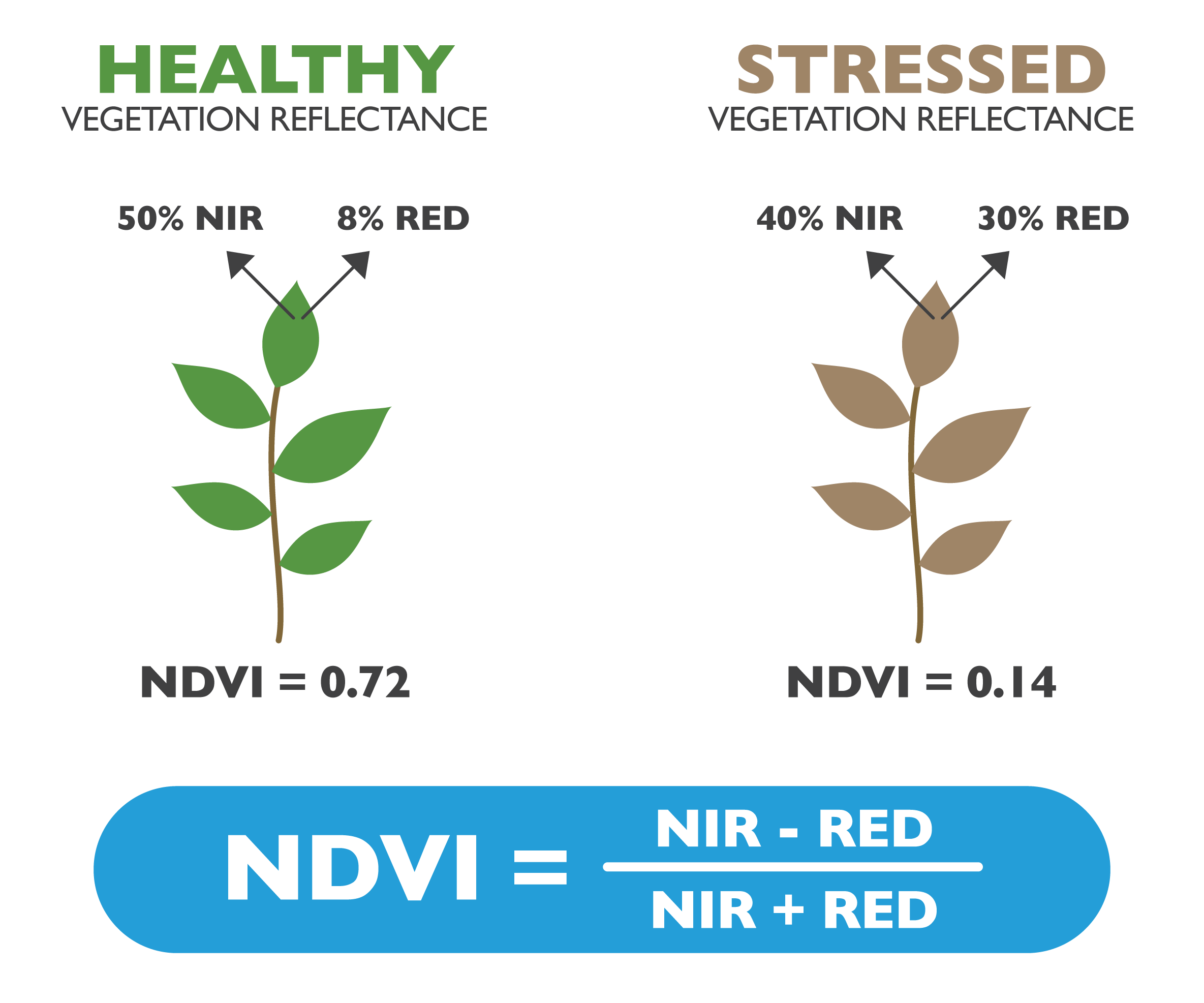The spread of digital technologies in farms has led to an increasing use of vegetation indices, such as NDVI, for crop control by using remote sensing.
Vegetation indices are calculated thanks to data collected from drones or satellites. Commonly used satellites have regular acquisition intervals, such as 5 days (Sentinel 2) or 16 days (Landsat 8), so indices are available for multiple dates in the same season.
The sun emits radiation with different wavelengths and frequencies. The electromagnetic spectrum (EM spectrum) indicates the totality of all possible frequencies of electromagnetic radiation. The whole spectrum is divided into the part of the visible spectrum, which generates light, and the parts of the non-visible spectrum at longer and shorter wavelengths of the visible spectrum

Electromagnetic spectrum (EM spectrum)
Vegetation absorbs solar radiation in different bands, that is in different frequency ranges and wavelengths, and emits a different percentage of it back into them. The percentage of refracted radiation in specific bands, such as near infrared (NIR), red (RED), and short-wave infrared (SWIR), varies with plant health and water stress .

Vegetation indices with percentage of radiations emitted
The vegetation indices are a combination of the percentage of refracted radiation in different specific bands.

The most used vegetation index is undoubtedly the NDVI (Normalized Difference Vegetation Index): it describes the vigour level of the crop and it is calculated as the ratio between the difference and the sum of the refracted radiations in the near infrared and in the red, that is as (NIR-RED)/(NIR+RED).
The interpretation of the absolute value of the NDVI is highly informative, as it allows the immediate recognition of the areas of the farm or field that have problems. The NDVI is a simple index to interpret: its values vary between -1 and 1, and each value corresponds to a different agronomic situation, regardless of the crop.
| NDVI | INTERPRETATION |
|---|---|
| <0.1 | Bare soil |
| 0.1 – 0.2 | Almost absent canopy cover |
| 0.2 – 0.3 | Very low canopy cover |
| 0.3 – 0.4 | Low canopy cover, low vigour or very low canopy cover, high vigour |
| 0.4 – 0.5 | Mid-low canopy cover, low vigour or low canopy cover, high vigour |
| 0.5 – 0.6 | Average canopy cover, low vigour or mid-low canopy cover, high vigour |
| 0.6 – 0.7 | Mid-high canopy cover, low vigour or average canopy cover, high vigour |
| 0.7 – 0.8 | High canopy cover, high vigour |
| 0.8 – 0.9 | Very high canopy cover, very high vigour |
| 0.9 – 1.0 | Total canopy cover, very high vigour |
Table 1
The average NDVI of a field varies according to the variety and phenological stage of the crop.
In a field, where a crop tends to be at the same phenological stage, areas with a significantly lower than average NDVI value present problems in vegetative development, for example:
- nutritional stress,
- parasitic attacks,
- hail damage or frost.
In order to identify the potentially problematic areas in each field, the minimum and maximum NDVI values are identified. Then the interval is divided into 5 parts, each corresponding to a different level of vegetative stress: the areas of the field where the NDVI is lowest are those in which the plant is most stressed.

NDVI imagery Agricolus
NDMI interpretation
The NDMI (Normalized Difference Moisture Index) describes the crop’s water stress level and is calculated as the ratio between the difference and the sum of the refracted radiations in the near infrared and SWIR, that is as (NIR-SWIR)/(NIR+SWIR).
The interpretation of the absolute value of the NDMI makes possible to immediately recognize the areas of the farm or field with water stress problems. NDMI is easy to interpret: its values vary between -1 and 1, and each value corresponds to a different agronomic situation, independently of the crop (Table 2).
| NDMI | INTERPRETATION |
|---|---|
| -1 – -0.8 | Bare soil |
| -0.8 – -0.6 | Almost absent canopy cover |
| -0.6 – -0.4 | Very low canopy cover |
| -0.4 – -0.2 | Low canopy cover, dry or very low canopy cover, wet |
| -0.2 – 0 | Mid-low canopy cover, high water stress or low canopy cover, low water stress |
| 0 – 0.2 | Average canopy cover, high water stress or mid-low canopy cover, low water stress |
| 0.2 – 0.4 | Mid-high canopy cover, high water stress or average canopy cover, low water stress |
| 0.4 – 0.6 | High canopy cover, no water stress |
| 0.6 – 0.8 | Very high canopy cover, no water stress |
| 0.8 – 1.0 | Total canopy cover, no water stress/ waterlogging |
Table 2: Agricolus NDMI index
The average NDMI of a field also varies according to the variety and phenological stage of the crop.
In a field, where a crop tends to be at the same phenological stage, areas where the NDVI value is significantly lower than average normally present vegetative development problems associated with water stress.
In order to identify the risk areas in each field, the minimum and maximum NDMI values are identified. The interval is then divided into 5 parts, each corresponding to a different level of water-vegetative stress: the areas of the field where the NDMI is lowest are those where the plant is most stressed.
La funzionalità Imagery nella piattaforma Agricolus
The Agricolus platform for precision agriculture offers Imagery functionality both for the whole farm and for single field. Are provided multiple indices of vegetation such as vigor (NDVI, WDRVI, GNDVI, LAI, SAVI) water stress (NDMI and NMDI) and chlorophyll (TCARI/OSAVI) calculated from Sentinel 2 data. The satellite shows images every 5 days at a spatial resolution of 10 meters and indices are available for all dates of acquisition of the last 365 days.
The benefits for the farm?
- Evaluate the development and health status of the crop,
- differentiate areas with water shortage,
- identify problematic areas with chlorosis.






